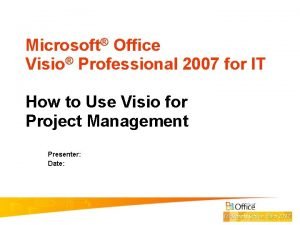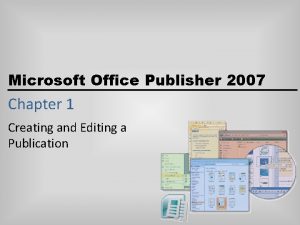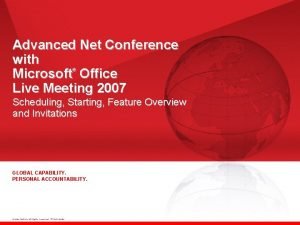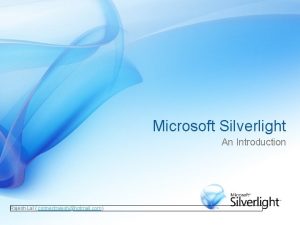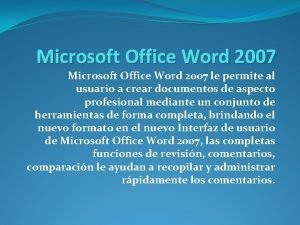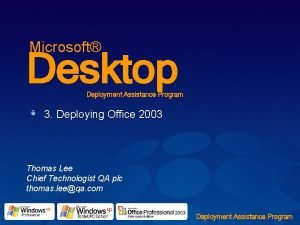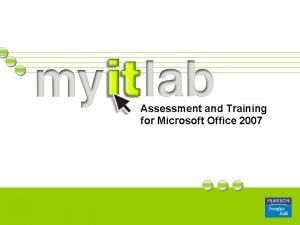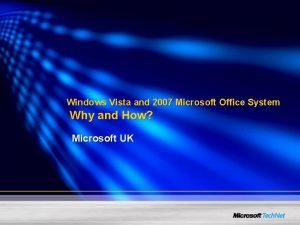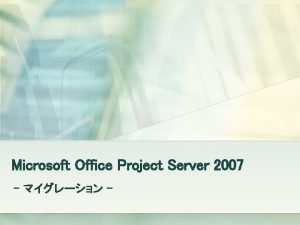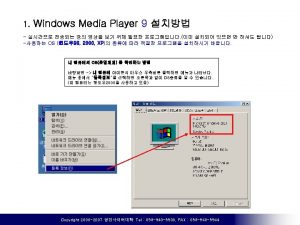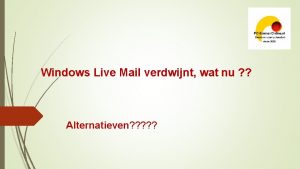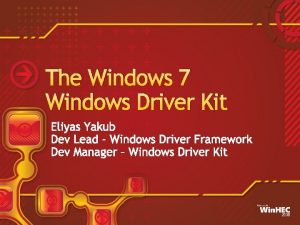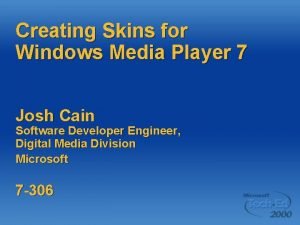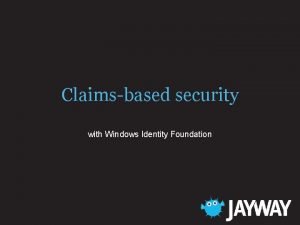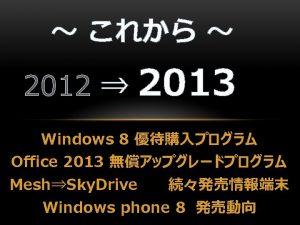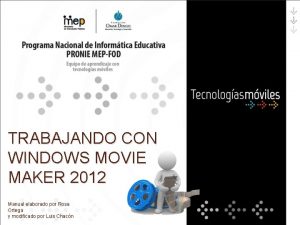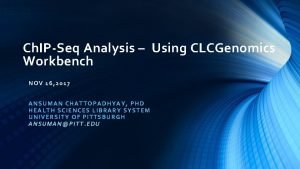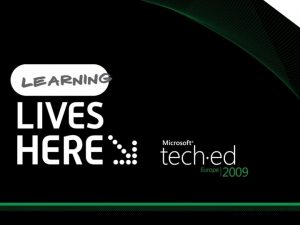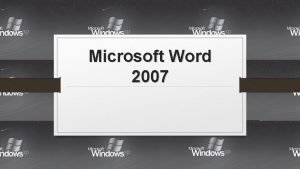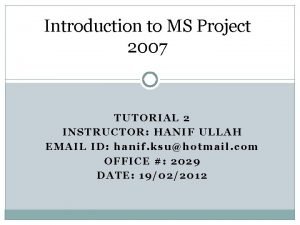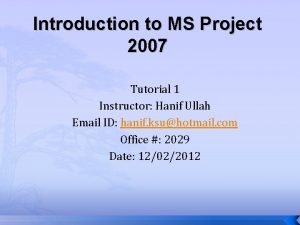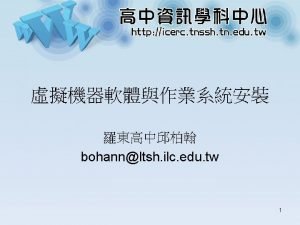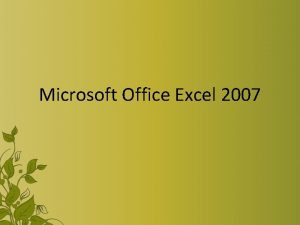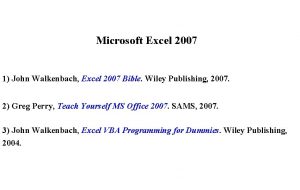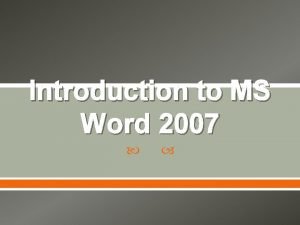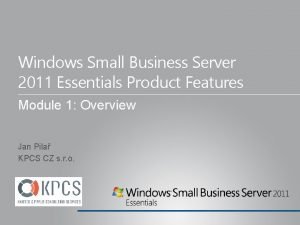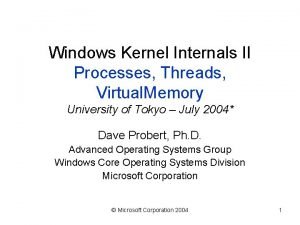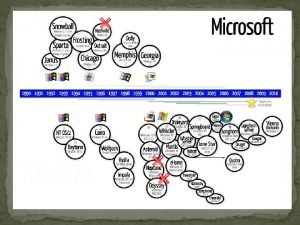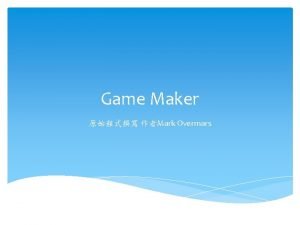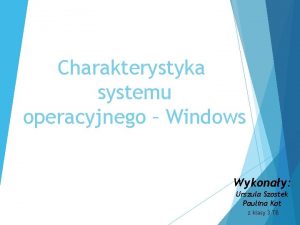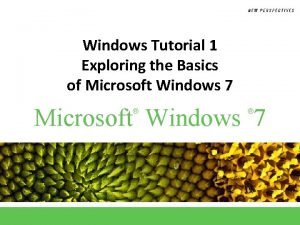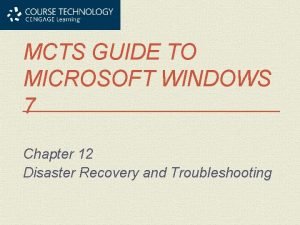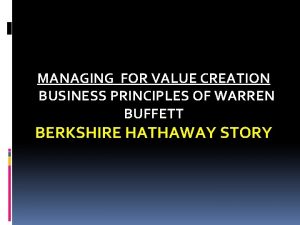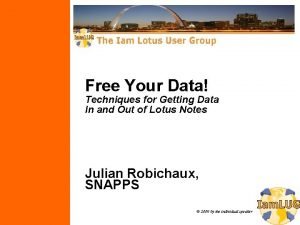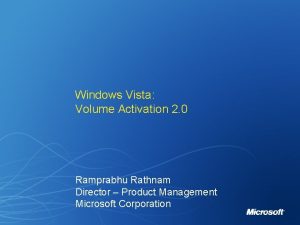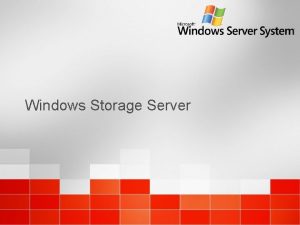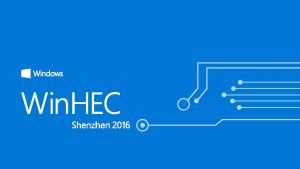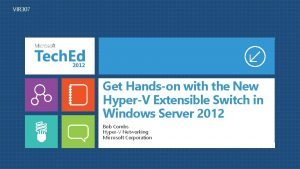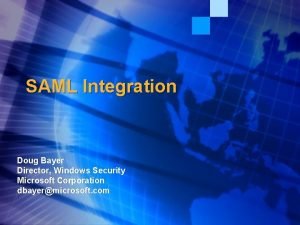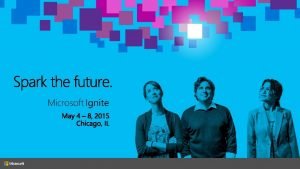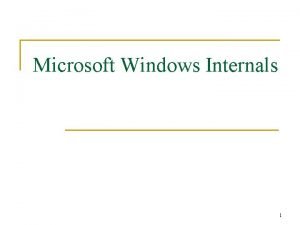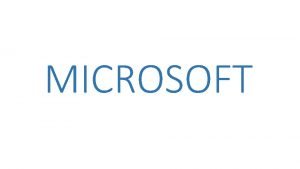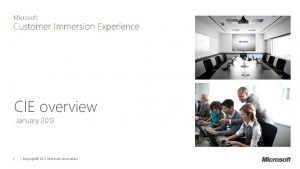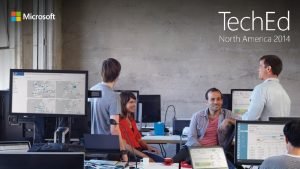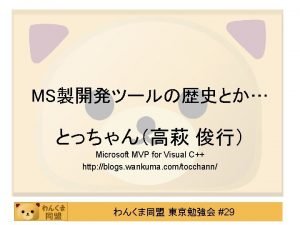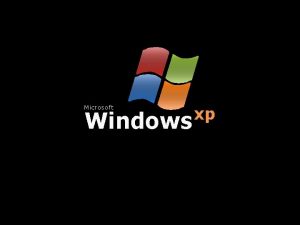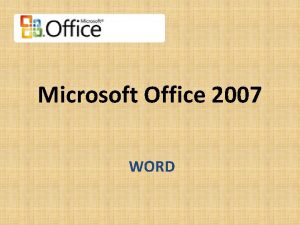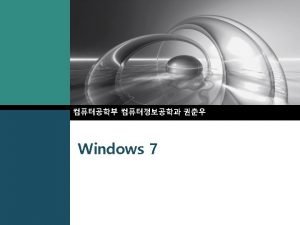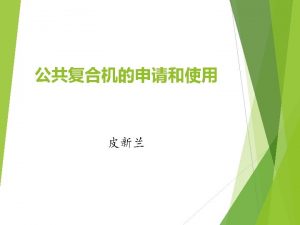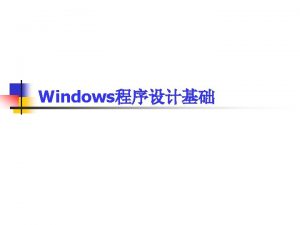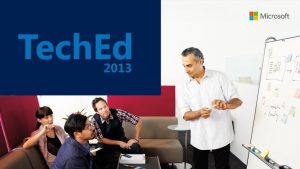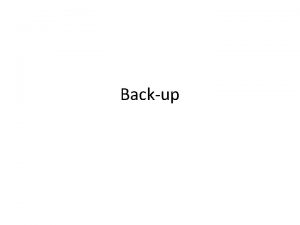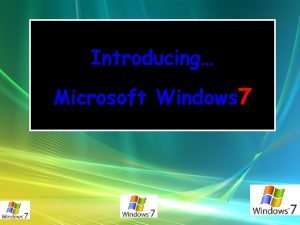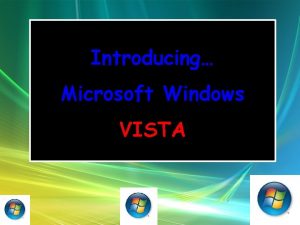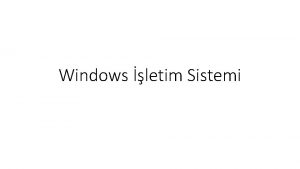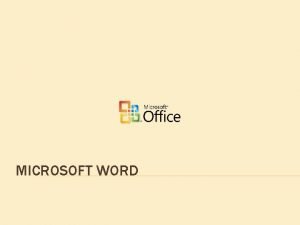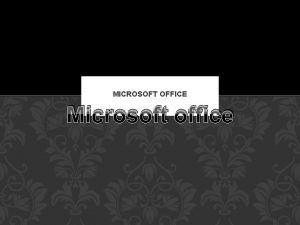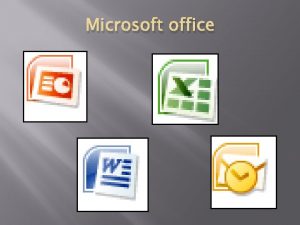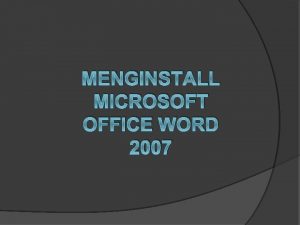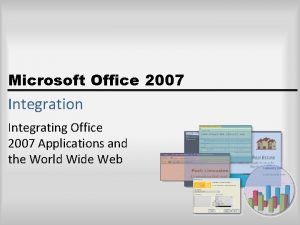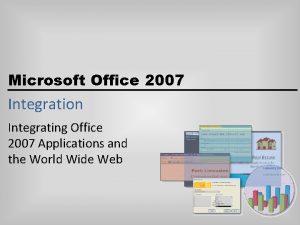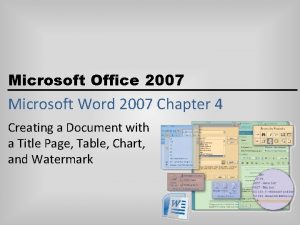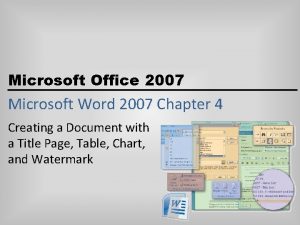Microsoft Office 2007 Microsoft Windows XP Introduction to























































- Slides: 55

Microsoft Office 2007 Microsoft Windows XP Introduction to Microsoft Windows XP

Chapter Concepts • Overview of operating systems – Purpose – Current OS – Interface • Drives, files and folders • Using Windows to perform tasks Microsoft Office 2007: Introductory Concepts and Techniques 2

Operating System Overview • Operating system (OS): software that controls a computer – Manages hardware, including memory – Runs applications – Provides an interface for users – Retrieves and manipulates files • OS acts as “middleman” between user, applications, hardware • Computer needs only one operating system – May have more Microsoft Office 2007: Introductory Concepts and Techniques 3

Operating system as “middleman” Microsoft Office 2007: Introductory Concepts and Techniques 4

Current Operating Systems • Windows – XP – Vista – Windows 7 – Windows 8 under development • Macintosh OS X • Linux • Others Microsoft Office 2007: Introductory Concepts and Techniques 5

Windows Interface • Goal of interface: provide a means to pass commands into the system and get results back • Windows has a GUI (Graphical User Interface) – User-friendly – Office analogy • Event-driven: actions occur in response to some event – By user: mouse-click, double-click, keypress, etc – By system: clock tick, start-up, etc – By application: request for memory Microsoft Office 2007: Introductory Concepts and Techniques 6

Windows Interface (cont) • Mouse pointer: arrow or other shape that moves when the user moves the mouse • Cursor: Upright line, or I-beam, that appears where text can be entered • Tooltips: small notes that often appear on screen when the pointer is rested on an object • Keyboard shortcuts: keystrokes that perform an action; can be used instead of mouse Microsoft Office 2007: Introductory Concepts and Techniques 7

Common Mouse Manipulations • Left click: click and release the left mouse button • Right click: click and release the right button • Double-click: click the left mouse button twice in rapid succession • Drag: hold down the left mouse button and move the mouse without releasing the button • Select: left-click an object once to select it; the object will usually be highlighted or shown differently Microsoft Office 2007: Introductory Concepts and Techniques 8

Windows Desktop • Overall work area; the screen that appears when all windows are closed • Can have – Recycle bin – Shortcuts to documents or applications – Documents and/or folders – Start button – Quick launch toolbar – Taskbar – Notification area (system tray or systray) Microsoft Office 2007: Introductory Concepts and Techniques 9

Windows Desktop (cont) • Taskbar: bottom of Desktop (can be moved) – Shows open programs, gives quick access to others • Quick launch icons: fast access to programs • Icons for running applications – In XP, hovering over application icon displays tooltip with name – In Vista, hovering over application icon displays thumbnail • Notification Area (system tray or systray): services running in the background Microsoft Office 2007: Introductory Concepts and Techniques 10

Start Button Quick Launch Toolbar Running Programs Systray 11

Windows Desktop (cont) • To customize the desktop – Right-click an empty space – Select Properties from the popup menu • Can change many things; most often desktop picture and screen saver • To customize the Taskbar or Start Menu – Right-click either one – Select Properties from the popup menu – Click either the Taskbar or the Start Menu tab Microsoft Office 2007: Introductory Concepts and Techniques 12

Start Button • Displays – Most recently used programs – Most recent documents – Some system utilities • Control panel: customizes computer; adds/removes programs • Printers and faxes: shows installed printers; adds new ones – Help • Log off / Turn off computer • All Programs Microsoft Office 2007: Introductory Concepts and Techniques 13

Start Button – All Programs • To close, click an open area on Desktop or press Esc key • Shows all available programs – An arrow indicates more menu items – Accessories has some small programs provided by the operating system – Accessories, System Tools has tools • Find out more about your system • Make it run better • To run a program – Find it in All Programs – Click on it Microsoft Office 2007: Introductory Concepts and Techniques 14

Displaying the Start Menu Microsoft Office 2007: Introductory Concepts and Techniques 15

Desktop Shortcuts • Icon on desktop • Fast way to access often-used programs – Double-click icon to start program • To add a shortcut to the desktop – Click the Start button to display the Start menu – Locate the program you want and right-click it – From the popup menu • Click Send To • Then click Desktop (create shortcut) Microsoft Office 2007: Introductory Concepts and Techniques 16

Desktop Shortcuts • Not all icons on desktop are shortcuts – Some are folders or documents – Shortcuts have curved arrow in lower left corner • To delete shortcut – Single click it to select, then press the Del key – Or, drag it to the Recycle Bin Microsoft Office 2007: Introductory Concepts and Techniques 17

Recycle Bin • A temporary storage area for deleted items – When an item on the C: drive is deleted, it goes into the recycle bin – When an item on any other drive is deleted, it’s really gone • To get a deleted item back – Double-click the recycle bin – Find the item in the list – Right-click it and click Restore from the popup menu • If you’re really sure you want items in the recycle bin deleted – Right-click it, click Empty recycle bin from the popup Microsoft Office 2007: Introductory Concepts and Techniques 18

Window Manipulation • Running application usually shown in a window • Icons at top right of the window close it; minimize it; and maximize it • If the window is already maximized, the Maximize button turns into a Restore button – Restore button makes the window fill only part of the screen • Can be dragged across the screen by the title bar • Can be re-sized by dragging an edge (pointer will be a double-headed arrow) Microsoft Office 2007: Introductory Concepts and Techniques 19

Windows Clipboard • An area of memory to which a single item can be saved (copied) • An item on the Clipboard can be pasted in any appropriate location • After pasting, the item is still on the clipboard – Can be pasted multiple times • When another item is copied to the clipboard, it takes the place of the previous item Microsoft Office 2007: Introductory Concepts and Techniques 20

Drives • Each storage media (hard disk, USB, CD/DVD) is called a drive • Drives are lettered to identify them (followed by a colon and backslash) • A: and B: are floppy drives; many computers don’t have them anymore • C: is the hard drive – Sometimes the hard drive is divided and gets additional letters • The optical drive gets the next letter, usually D: • Other drives get assigned letters, usually in order but not always Microsoft Office 2007: Introductory Concepts and Techniques 21

Drives (cont) • Networked computers may have drives that are really on a server, but seem to be on the computer • On this campus – C: is the hard drive on each computer – H: is a network drive; located on the server • Each student has an H: drive associated with his/her account Microsoft Office 2007: Introductory Concepts and Techniques 22

Drives (cont) • On this campus (cont) – The Public drive is a network drive and is located on the server – Anything saved on a C: drive stays on that computer – Anything saved on the H: drive is on the server and is accessible on other computers on campus • Although the computer identifies drives by letter, sometimes humans give drives names also – For example, the Public drive is a network drive • It has a letter, but is more easily referred to as Public Microsoft Office 2007: Introductory Concepts and Techniques 23

Folders • A container for files or other folders • Analogous to a file folder used in a file cabinet in an office • User to organize files in a logical way – All Intro files can be kept together in a folder – All Science files can be kept together in a folder • Terms Folder and Directory used interchangeably • Folders may contain other folders – May be nested to many levels • A folder named My Documents is usually created for you when you get an account on a system • You can create other folders Microsoft Office 2007: Introductory Concepts and Techniques 24

Files • File: a collection of related data treated as a unit – A letter to your mom – A picture of your cat – A song – A financial spreadsheet – A game program – An address list • A file is whatever you decide to make into a file • Analogous to the pieces of paper in a file cabinet Microsoft Office 2007: Introductory Concepts and Techniques 25

Filenames • Files are given names to distinguish them from other files – A descriptive name helps you remember what a file is – Name usually consists of three parts • A name: this is the part that helps you remember what is in the file • A dot • An extension: this tells the system what program was used to make the file; it is usually added by the program – Example: Intro. Assign 1. docx Microsoft Office 2007: Introductory Concepts and Techniques 26

File Paths • Path: a full description of where a file is located on a system • Consists of – Drive letter (including the colon and backslash) – Any folder names, in order (separated by a backslash) – Filename (including the extension) Example: C: My Documentsclasses11000 IntroAssign 1. docx Microsoft Office 2007: Introductory Concepts and Techniques 27

Storage devices such as a USB drive, CD, or hard drive, are organized into directories and subdirectories that contain files Microsoft Office 2007: Introductory Concepts and Techniques 28

My Computer • Also called Windows Explorer (not the same as Internet Explorer) • Displays the files on your system • Allows you to create, delete, rename folders and files • To access My Computer – Click the Start button, click My Computer – Or press the keys Win+e on the keyboard • The Win key is the one with the flag • To press Win+e, hold down the Win key and press e Microsoft Office 2007: Introductory Concepts and Techniques 29

Microsoft Office 2007: Introductory Concepts and Techniques 30

My Computer (cont) • Your My Computer window may look somewhat different, depending on your system settings • You can change the look of My Computer in two ways 1. Click the menu item View and select either Thumbnails, Tiles, Icons, List, or Details. The same information is presented, but with a different look 2. Click the Folders icon on the toolbar. This turns the left pane on and off. Microsoft Office 2007: Introductory Concepts and Techniques 31

My Computer – Navigation • Click the Folders icon to toggle the left pane that shows folders • To “open” a folder and drill down to subfolders inside folders – In right pane, double-click the folder, or – If left pane is showing, click + signs in XP or arrowheads in Vista beside the folder name • Use forward and back arrows (on the toolbar) to move through previous views • Save a commonly used folder in Favorites – Click the menu item Favorites – Click Add to favorites… – To retrieve, click Favorites, then the desired item Microsoft Office 2007: Introductory Concepts and Techniques 32

My Computer – Showing Extensions • By default, Windows does not show file extensions. • It is hard to differentiate between Myfile. docx and Myfile. xlsx without seeing the extensions • To display extensions – In My Computer, select the menu item Tools – Select the sub-menu item Options – In the resulting dialog box, click the View tab – Scroll down, and find the item Hide extensions for known file types – Unclick the checkbox, then click OK Microsoft Office 2007: Introductory Concepts and Techniques 33

My Computer – Creating a Folder • Select parent folder by single-clicking it – Right-click in the white area of the right pane – Select New from the shortcut menu – Select one of the choices for folder types • XP choices: Folder and Shortcut • Vista choices: Folder, Shortcut, Compressed (Zipped) – Folder is created and highlighted so that it may be renamed • To rename an existing file or folder, select it, then press F 2 (or rightclick and choose Rename) • Can create folders within folders • The desktop is itself a folder, and can have sub-folders Microsoft Office 2007: Introductory Concepts and Techniques 34

My Computer – File/Folder Manipulation • Terms – Source: an item’s starting location – Destination: where you want an item to go • Move – Drag and drop item to its destination (if moved to a different drive, original stays in place; otherwise not) • Rename – Right-click item, select Rename from shortcut menu, type new name, press Enter – Or, click item to select, press the key F 2, type new name, press Enter Microsoft Office 2007: Introductory Concepts and Techniques 35

My Computer – File/Folder Manipulation (cont) • Copy – Right-click item, select Copy from the shortcut menu – Right-click in white area of destination folder – Select Paste from the shortcut menu • Alternative way to copy – Hold down Ctrl key, drag and drop item to destination • Delete – Right-click item, select Delete from the shortcut menu – Or, select item, press keyboard Del Microsoft Office 2007: Introductory Concepts and Techniques 36

USB Drives • Commonly-used removable storage – Lightweight – Holds a great deal of data – Easy to use – Also called Thumb Drives, Flash Drives, etc • To use – Insert drive into USB slot on computer • Slot is directional; if drive doesn’t enter easily, turn it over – Usually (but not always) a dialog box opens asking what you want to do with the drive; click your choice – Drive also appears in My Computer • Treat the same as any other drive Microsoft Office 2007: Introductory Concepts and Techniques 37

Search for a File or Folder • To begin – From My Computer click the Search icon on the toolbar – Or, from the Start button, click the Search button • • Either method will bring up a search window Maximize the window if necessary Click link at bottom Click here to use search companion Click on the type of item you are searching for Enter as much data as possible about the item Click Search Results will be displayed (it may take a few minutes to search your computer) Microsoft Office 2007: Introductory Concepts and Techniques 38

Using Windows Help • Starting Help and Support – Display the Start menu – Click Help and Support to display the Help and Support Center window – If necessary, click the Maximize button on the Help and Support Center title bar to maximize the Help and Support Center window Microsoft Office 2007: Introductory Concepts and Techniques 39

Starting Help and Support Microsoft Office 2007: Introductory Concepts and Techniques 40

Browsing for Help Topics in the Table of Contents • Select one of the topics in the Pick a Help topic area to display the Navigation Pane and topic pane • Select a sub-topic in the Navigation Pane on the left – Click a plus (+) icon to expand a topic • Click a link in the topic pane on the right to see details Microsoft Office 2007: Introductory Concepts and Techniques 41

Browsing for Help Topics in the Table of Contents Microsoft Office 2007: Introductory Concepts and Techniques 42

Searching for Help Topics Using the Index • Click the Index button on the Navigation toolbar to display the Index pane • Type a word or phrase in the Type in the keyword to find text box • Click an entry in the Index entries list • Click the Display button – Displays information about the topic – You may get a popup box asking you to choose between several related entries Microsoft Office 2007: Introductory Concepts and Techniques 43

Searching for Help Topics Using the Index Microsoft Office 2007: Introductory Concepts and Techniques 44

Displaying the Related Topics Link • Scroll to the bottom of the information about a topic in the right pane to display the Related Topics link • Click the Related Topics link to display a pop-up window containing a list of related topics Microsoft Office 2007: Introductory Concepts and Techniques 45

Displaying the Related Topics Link Microsoft Office 2007: Introductory Concepts and Techniques 46

Closing the Help and Support Center • Click the Close button on the title bar of the Help and Support Center window to close the Help and Support Center window Microsoft Office 2007: Introductory Concepts and Techniques 47

Keyboard Shortcuts • Some users prefer using key combinations to perform an action instead of using the mouse – More efficient when typing – Example: ctrl+c is the same as the menu item Copy • Two- or three-key combinations written with a plus or dash between them mean to hold down the first key (or keys) and then press the last key Microsoft Office 2007: Introductory Concepts and Techniques 48

Keyboard Shortcuts (cont) • To find shortcuts – Use the index in Help and Support – Type in keyboard shortcuts – Display the topic List of keys – The right pane will have categories of shortcuts, such as General Keyboard Shortcuts – Expand a category by clicking the plus sign Microsoft Office 2007: Introductory Concepts and Techniques 49

Application Software • Some comes with operating system – Tools – Games – Browser • Some installed by computer manufacturer – Often trial versions • Some can be downloaded from the internet for free or low price – Might also come with a free virus!! Be careful!! • Some must be bought – Often academic pricing is very low Microsoft Office 2007: Introductory Concepts and Techniques 50

Logging Off from the Computer • Display the Start menu • Click Log Off on the Start menu to display the Log Off Windows dialog box • Click the Log Off button in the Log Off Windows dialog box to log off from the computer and display the Welcome screen Microsoft Office 2007: Introductory Concepts and Techniques 51

Logging Off from the Computer Microsoft Office 2007: Introductory Concepts and Techniques 52

Turning Off the Computer • Click the Turn off computer link on the Welcome screen • Click the Turn Off button in the Turn off computer dialog box Microsoft Office 2007: Introductory Concepts and Techniques 53

Turning Off the Computer Microsoft Office 2007: Introductory Concepts and Techniques 54

On Campus • Log off and Turn Off dialog boxes are somewhat different Microsoft Office 2007: Introductory Concepts and Techniques 55
 Office 2007 visio
Office 2007 visio Ms project 2007
Ms project 2007 Ms publisher 2007
Ms publisher 2007 Office live meeting 2007
Office live meeting 2007 Adobe acrobat wiki
Adobe acrobat wiki Groove 2007
Groove 2007 Windows movie maker windows 7
Windows movie maker windows 7 Silverlight seminar ppt download
Silverlight seminar ppt download Micro office word 2007
Micro office word 2007 Ose exe
Ose exe Office 2007 training
Office 2007 training 2007 office system
2007 office system Project server 2007
Project server 2007 Live windows movie maker
Live windows movie maker Windows media player 9
Windows media player 9 Windows live mail xp
Windows live mail xp Windows driver kit windows 7
Windows driver kit windows 7 Windows media player themes
Windows media player themes Windows identity foundation windows 10
Windows identity foundation windows 10 Upgrade windows 7 to windows 10
Upgrade windows 7 to windows 10 Windows xp vm image download
Windows xp vm image download Nokia lumia 920 windows 10
Nokia lumia 920 windows 10 Download movie maker 2012
Download movie maker 2012 Windows vista windows 10
Windows vista windows 10 Windows xp
Windows xp Tombol size button terletak di bagian pojok
Tombol size button terletak di bagian pojok Ms project 2007 training
Ms project 2007 training Ms project 2007 tutorial
Ms project 2007 tutorial Virtual pc player
Virtual pc player Microsoft excel 2007 secara umum berfungsi untuk
Microsoft excel 2007 secara umum berfungsi untuk John walkenbach
John walkenbach Ms word 2007 introduction
Ms word 2007 introduction Difference between office location and office layout
Difference between office location and office layout Small business server 2010
Small business server 2010 Windows small business server 2011 end of life
Windows small business server 2011 end of life Microsoft-windows-kernel-process
Microsoft-windows-kernel-process Introduccion de microsoft
Introduccion de microsoft Windows live movie maker microsoft
Windows live movie maker microsoft Windows 7 premiera
Windows 7 premiera Microsoft windows tutorial
Microsoft windows tutorial Microsoft windows armendicott
Microsoft windows armendicott Microsoft windows logos
Microsoft windows logos Microsoft microsoft edge startwarren theverge
Microsoft microsoft edge startwarren theverge Microsoft windows logos
Microsoft windows logos Volume activation management tool download
Volume activation management tool download Windows storage server 2003
Windows storage server 2003 Microsoft windows 10 security update
Microsoft windows 10 security update Windows filtering platform
Windows filtering platform Doug jones windows
Doug jones windows Lsaiso
Lsaiso Microsoft windows internals
Microsoft windows internals Microsoft windows 2005
Microsoft windows 2005 Microsoft is changing to black windows
Microsoft is changing to black windows Microsoft back against windows
Microsoft back against windows Microsoft windows 3.x
Microsoft windows 3.x Lembar kerja program aplikasi pengolah angka adalah ....
Lembar kerja program aplikasi pengolah angka adalah ....
